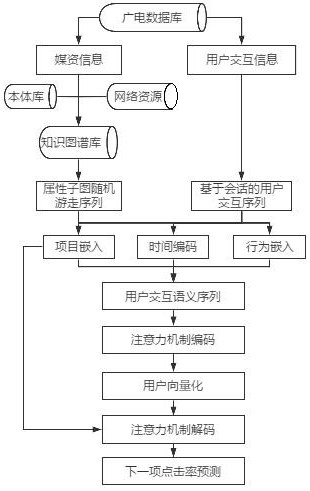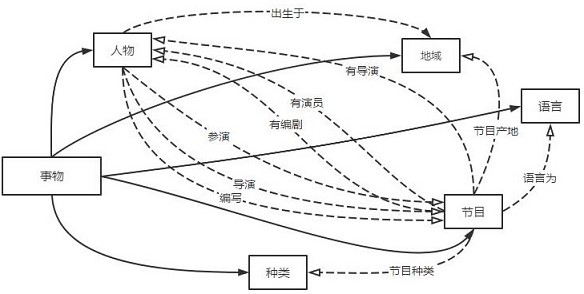A radio and television program recommendation method based on knowledge graph and user micro-behavior
A knowledge graph and program recommendation technology, applied in the field of radio and television program recommendation based on knowledge graph and user micro-behavior, can solve problems such as not taking into account differences in user interests, ignoring the internal connection of content attributes, etc., to achieve strong correlation and enhance individuality effect
- Summary
- Abstract
- Description
- Claims
- Application Information
AI Technical Summary
Problems solved by technology
Method used
Image
Examples
Embodiment 1
[0107] The present invention proposes a method for recommending radio and television programs based on knowledge graphs and user microbehaviors, such as figure 1 As shown, it specifically includes the following steps:
[0108] Step S1: Build a knowledge graph in the field of radio and television;
[0109] Step S2: Sort out user micro-behavior data: divide user behavior interaction data into continuous micro-behavior and discrete micro-behavior according to behavior duration;
[0110] Step S3: Extract the attribute subgraph of the broadcasting field knowledge map constructed in step S1, and use the random walk method to extract a random walk program sequence Q according to the attribute subgraph; extract a random walk from one attribute subgraph Sequence Q, the random walk sequence Q of all attribute subgraphs together form an item sequence set H k ;
[0111] Step S4: Utilize the user's behavior interaction data sorted out in step S2 to construct a time session-behavior type...
Embodiment 2
[0118] This embodiment is based on the above-mentioned embodiment 1, in order to better realize the present invention, further, as figure 2 As shown, the specific operation is:
[0119]Step S1: Build a knowledge map in the field of radio and television: Crawl the network resources of radio and television programs, form structured data through entity alignment, and use the ontology modeling tool protégé to complete the ontology construction; after the ontology construction is completed, use d2rq to store the original in the relation The data in the large-scale database is converted into the corresponding rdf format, and then stored in the form of a graph database, and then the construction of the knowledge map in the field of broadcasting and television is completed.
[0120] In order to better realize the present invention, further, when constructing the knowledge map in the field of broadcasting and television, the knowledge map is constructed in a top-down manner, and the d...
Embodiment 3
[0123] In this embodiment, on the basis of any one of the above-mentioned embodiments 1-2, in order to better realize the present invention, further, the specific operation of the step S2 is: divide the user's behavior interaction data into continuous Continuous micro-behaviors and discrete micro-behaviors; the continuous micro-behaviors are user behaviors that can last for a certain period of time, including live viewing, on-demand viewing, and search and viewing behaviors; the discrete micro-behaviors are user behaviors that only occur at a certain moment Behaviors, including purchases, favorites, and likes; collect the data detected by the background of the radio and television system to form structured data that records user numbers, media asset numbers, behavior types, behavior timestamps, and behavior durations. The behavior duration of the behavior is the corresponding valid value, and the behavior duration of the discrete behavior type is null.
[0124] Other parts of ...
PUM
 Login to View More
Login to View More Abstract
Description
Claims
Application Information
 Login to View More
Login to View More - R&D
- Intellectual Property
- Life Sciences
- Materials
- Tech Scout
- Unparalleled Data Quality
- Higher Quality Content
- 60% Fewer Hallucinations
Browse by: Latest US Patents, China's latest patents, Technical Efficacy Thesaurus, Application Domain, Technology Topic, Popular Technical Reports.
© 2025 PatSnap. All rights reserved.Legal|Privacy policy|Modern Slavery Act Transparency Statement|Sitemap|About US| Contact US: help@patsnap.com



